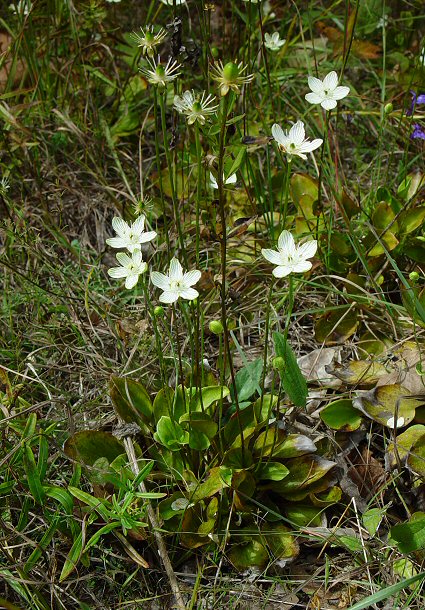Parnassia grandifolia DC.
Grass-Of-Parnassus

Native
CC = 10
CW = -5
MOC = 13
© DETenaglia
Parnassia grandifolia DC.Grass-Of-Parnassus | |
 |
Native CC = 10 CW = -5 MOC = 13 |
© DETenaglia |
|
Family - Parnassiaceae Habit - Perennial forb, usually with short rhizomes, glabrous, often with areas of minute rusty brown dots. Stems - To 45 cm, erect, unbranched, glabrous, perennial from rhizome. Leaves - Basal, long petiolate, the petiole broadened near the blade, glabrous. Blades simple, entire, thick textured, broadly ovate to orbicular, rounded at tip, rounded to cordate at base, palmately veined. Solitary leaflike bract present near midpoint of flowering stem, this sessile, broadly rounded, glabrous.
Inflorescences - Solitary flowers at tips of flowering stems. Flowers - Flowers perfect, actinomorphic, mostly hypogynous. Hypanthium absent or nearly so. Sepals 5, basally fused, 3-4 mm long, elliptic-ovate, usually prominently veined, ascending at flowering, persistent and becoming reflexed at fruiting. Petals 5, 12-22 mm long, spreading, oblong-elliptic to elliptic-ovate, white, with 7-11, prominent, green, mostly parallel veins, the outermost of these with several branches toward the margin. Stamens 5, alternating with the petals, the anthers attached toward the base, pink. Staminodes 5, opposite the petals, somewhat longer than the fertile stamens, each divided at or toward the base into 3 filament-like stalks, each stalk with a glistening capitate tip. Pistil 1 per flower, of 4 fused carpels. Ovary superior, bright green, with 1 locule, with numerous ovules, the placentation parietal. Style absent or nearly so, the 4 stigmas club-shaped to more or less capitate, outwardly curved.
Fruits - Capsules, 11-16 mm long, ovoid, dehiscing longitudinally, with numerous seeds. Seeds 0.7- 1.4 mm long, irregularly ovate to tetrahedral in outline, somewhat flattened, the outer covering loose, somewhat wrinkled, and winglike, the surface with a minute network of hexagonal pits, brown.
Flowering - August - October. Habitat - Fens and calcareous seeps. Origin - Native to the U.S. Lookalikes - None. Other info. - This uncommon species is one of the most attractive wildflowers around. The common name is nonsensical, as the plant is unrelated to grasses and looks nothing like a grass. Even the scientific species name (grandifolia) is peculiar, as it refers to the leaves rather than the unique and beautiful flowers. The plant is easily identified by its basal leaves and distinctive white flowers with green veins. The appearance is unlike anything else in Missouri's flora. This species is uncommon throughout its range, which is scattered throughout the southeastern U.S. It is an indicator of high quality calcareous fens. Photographs taken at the Shut-Ins Mountain Fen, Shannon County, MO., 8-31-03 (DETenaglia); also near Washington State Park, Washington County, MO, 8-30-2018 and 9-24-2018 (SRTurner). |